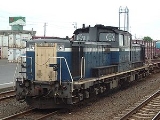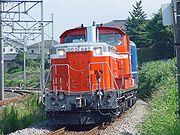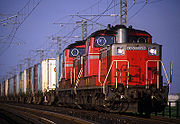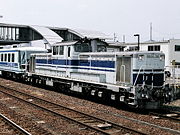
JNR Class DD51
Encyclopedia
The DD51 is a class of Japanese B-2-B wheel arrangement diesel-hydraulic locomotives. 649 locomotives were built between 1962 and 1978 by Kawasaki Sharyō
, Hitachi, and Mitsubishi
. The class was designed for mainline passenger and freight use with more power than the D51
and a higher maximum speed than the C62 steam locomotive classes. This was achieved by installing two 1,100 hp engines in an 18 metre long centre-cab design, unusual for mainline operation. The V12 DML61 engines were developed from the 6-cylinder inline DMF31 engines used in the DD13 locomotives.
, and locos numbered DD51 800 to 899 and 1801 to 1805 were built without steam generators
for train heating.
sport a livery based on the DF200
colour scheme, with no white stripe. These locomotives are frequently used in pairs double-heading
freight trains.
JR Hokkaidō locos are all finished in the "Hokutosei" livery of blue with a gold stripe and shooting star logo. These are used in pairs for hauling sleeper trains (Hokutosei
, Cassiopeia
, and Twilight Express
) between Hakodate and Sapporo.
DD51 592 (now withdrawn), and now DD51 791, was repainted in the "Euroliner" livery of pale blue with dark blue stripes for use with JR Central's "Euroliner" Joyful Train
set.
DD51 842 was designated as the Imperial Train locomotive. Whereas regular members of the class have white handrails and edges to the running boards, they are polished stainless steel on this particular locomotive, as are the exhaust shrouds. Based at Takasaki Depot, it is also used for special excursion trains.
DD51 class locomotives also formed the basis for the DD17, DD18, and DD19 self-propelled snow plough units.
in April 1998 and repainted in its original livery of brown with white lining. This locomotive was withdrawn March 1986, and was subsequently stored at Takasaki Depot from March 1987.



, and Tomix
.
In the 1970s, Endo produced a brass model DD51 in N gauge, but it is also out of production. An HO gauge precision brass model of the DD51 was made by Tenshodo, Tetudo Mokeisha, and Endo, and a plastic model of the DD51 is made by Kato
.
Kawasaki Heavy Industries
is an international corporation based in Japan. It has headquarters in both Chūō-ku, Kobe and Minato, Tokyo.The company is named after its founder Shōzō Kawasaki and has no connection with the city of Kawasaki, Kanagawa....
, Hitachi, and Mitsubishi
Mitsubishi Heavy Industries
, or MHI, is a Japanese company. It is one of the core companies of Mitsubishi Group.-History:In 1870 Yataro Iwasaki, the founder of Mitsubishi took a lease of Government-owned Nagasaki Shipyard. He named it Nagasaki Shipyard & Machinery Works, and started the shipbuilding business on a full scale...
. The class was designed for mainline passenger and freight use with more power than the D51
D51 steam locomotive
The is a type of 2-8-2 steam locomotive built by the Japanese Government Railways, the Japanese National Railways and various manufacturers from 1936 to 1951...
and a higher maximum speed than the C62 steam locomotive classes. This was achieved by installing two 1,100 hp engines in an 18 metre long centre-cab design, unusual for mainline operation. The V12 DML61 engines were developed from the 6-cylinder inline DMF31 engines used in the DD13 locomotives.
Variations
Locos numbered from DD51 501 to 799 and from 1001 to 1186 were equipped to operate in multipleMultiple-unit train control
Multiple-unit train control, sometimes abbreviated to multiple-unit or MU, is a method of simultaneously controlling all the traction equipment in a train from a single location, whether it is a Multiple unit comprising a number of self-powered passenger cars or a set of locomotives.A set of...
, and locos numbered DD51 800 to 899 and 1801 to 1805 were built without steam generators
Steam generator (railroad)
Steam generator is the term used to describe a type of boiler used to produce steam for climate control and potable water heating in railroad passenger cars...
for train heating.
Liveries
All locomotives numbered from DD51 2 onwards were finished in the standard diesel livery of orange/red with grey upper surfaces separated by a white stripe. Re-engined locos operated by JR Freight in HokkaidōHokkaido
, formerly known as Ezo, Yezo, Yeso, or Yesso, is Japan's second largest island; it is also the largest and northernmost of Japan's 47 prefectural-level subdivisions. The Tsugaru Strait separates Hokkaido from Honshu, although the two islands are connected by the underwater railway Seikan Tunnel...
sport a livery based on the DF200
JR Freight Class DF200
The DF200 class of diesel-electric locomotives are Bo-Bo-Bo wheel arrangement freight locomotives operated by JR Freight in Hokkaidō, Japan.As of 1 April 2009, 40 DF200s were operated by JR Freight, all based at Washibetsu Depot...
colour scheme, with no white stripe. These locomotives are frequently used in pairs double-heading
Double-heading
In railroad terminology, double-heading or double heading indicates the use of two locomotives at the front of a train, each operated individually by its own crew. The practice of triple-heading involves the use of three locomotives....
freight trains.
JR Hokkaidō locos are all finished in the "Hokutosei" livery of blue with a gold stripe and shooting star logo. These are used in pairs for hauling sleeper trains (Hokutosei
Hokutosei
The is a limited express sleeping car train service in Japan which connects Ueno Station in Tokyo and Sapporo Station in the northern island of Hokkaido, taking approximately 16½ hours...
, Cassiopeia
Cassiopeia (train)
The is a luxury overnight limited express train service in Japan operated by East Japan Railway Company . It runs between Ueno Station in Tokyo and the city of Sapporo in the northern island of Hokkaido. The one-way journey lasts approximately 16½ hours.Going from Ueno to Sapporo, trains call...
, and Twilight Express
Twilight Express
The is the longest overnight train service operating in Japan. Operated by West Japan Railway Company , it runs between the city of Sapporo on the northern island of Hokkaido and Osaka on south-western Honshu...
) between Hakodate and Sapporo.
DD51 592 (now withdrawn), and now DD51 791, was repainted in the "Euroliner" livery of pale blue with dark blue stripes for use with JR Central's "Euroliner" Joyful Train
Joyful Train
is the name given to railway rolling stock or train sets operated by the JR Group in Japan primarily for charters, special events, tourist excursions, and other similar purposes.-History:...
set.
DD51 842 was designated as the Imperial Train locomotive. Whereas regular members of the class have white handrails and edges to the running boards, they are polished stainless steel on this particular locomotive, as are the exhaust shrouds. Based at Takasaki Depot, it is also used for special excursion trains.
Refurbishment
As of April 2003, there were 138 DD51s still in service, with the vast majority operated by JR Freight. Of these, many have recently undergone life extension refurbishment, which includes removal of steam generator equipment where still fitted. These locos are distinguished by a new livery of blue with grey upper surfaces separated by a white stripe, and cream end panels.DD51 class locomotives also formed the basis for the DD17, DD18, and DD19 self-propelled snow plough units.
Fleet allocation
As of 1 April 2009] the DD51 fleet was as follows.- JR Hokkaido: 13 (including 1 stored)
- JR East: 4
- JR West: 9
- JR Freight: 68
Preserved examples
The prototype, DD51 1, with its unique, more rounded appearance, was moved to the Usui Pass Railway Heritage ParkUsui Pass Railway Heritage Park
The is an open-air railway museum located in Annaka, Gunma, Japan. It is operated by East Japan Railway Company , and was opened on 18 April 1998 on the site of the former Yokokawa motive power depot alongside the Shin'etsu Main Line, which closed in October 1997....
in April 1998 and repainted in its original livery of brown with white lining. This locomotive was withdrawn March 1986, and was subsequently stored at Takasaki Depot from March 1987.



Models
The DD51 is produced in N gauge by Micro Ace, KatoKato Precision Railroad Models
Kato Precision Railroad Models is a Japanese manufacturer of model railroad equipment in N and HO scales...
, and Tomix
Tomix
Tomix is model railway brand of the Japanese company Tomytec, a subsidiary of toy manufacturer Takara Tomy .-Product outline:...
.
In the 1970s, Endo produced a brass model DD51 in N gauge, but it is also out of production. An HO gauge precision brass model of the DD51 was made by Tenshodo, Tetudo Mokeisha, and Endo, and a plastic model of the DD51 is made by Kato
Kato Precision Railroad Models
Kato Precision Railroad Models is a Japanese manufacturer of model railroad equipment in N and HO scales...
.

